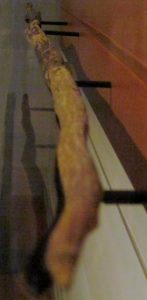Between February 1692 and May 1693 in current day Massachusetts, more than 200 people were accused of witchcraft. Of them, thirty were found guilty, and nineteen of whom were executed. This period of witch trials later came to be known as the Salem witch trials, named after the town of Salem and Salem Village (present-day Danvers).
Salem Village was known for its divided population with many internal disputes about property lines, grazing rights, and church privileges. After a series of short-term ministers, Samuel Parris became the first ordained minister of Salem Village in 1689. He was not successful in solving conflicts in the village; rather he contributed to the dissonance by making well-known church members suffer public penance due to their small mistakes. This only created more division among the people. According to Historian Marion Starkey, serious conflict was inevitable in this tense environment (1949).
In February 1692, Reverend Parris’ daughter Elizabeth, age 9, and niece, Abigail Williams, age 11, started having “fits” (Hale 1697). They would shriek, make weird sounds, crawl under furniture, and convulse into strange positions. These “fits” were considered to be supernatural in origin, and members of the community were accused of consorting with the devil and afflicting the young children through witchcraft (Lawson 1692). With the seeds of paranoia planted, more accusations arose, and more people were arrested. By the end of the month of May, a total of 62 individuals were in custody (Roach 2002).
On June 2, 1962, the Court of Oyer and Terminer (to hear and decide) was established to handle the large number of people in jail for witchcraft. These trials relied heavily on spectral evidence, or testimony based on dreams or apparitions seen by the afflicted. The “touch test” was also used to determine guilt or innocence. The accused witch was told to touch a victim having a fit, and if the victim stopped having a fit, the accused was believed to have afflicted the victim (Boyer & Nissenbaum 1972). Other evidence included confessions made by accused witches, and testimony by a guilty witch who pointed out others as witches. In January 1693, the new Superior Court of Judicature convened, and those who had been accused of witchcraft, but not yet tried, went on trial. The series of trials and executions finally ended in May 1693.
The Salem witch trials are an infamous case of mass hysteria; they are an example of the consequences of religious extremism, false allegations, and lapses in the due legal processes. These trials had a lasting effect on people’s attitude towards separation of state and church, as historian George Lincoln Burr said, “the Salem witchcraft was the rock on which the theocracy shattered” (1914:197). The Salem witch trials left a lesson for the future, a caution for the outcome of unbridled religious fanaticism and over enthusiasm about the supernatural.
Further reading on Finding the exact spot of witch execution in Salem and Witch trials in Europe
Reference list:
Boyer, Paul S., Stephen Nissenbaum
1972 Salem-Village Witchcraft: A Documentary Record of Local Conflict in Colonial New England. Northeastern University Press, Lebanon, New Hampshire.
Burr, George Lincoln
1914 Narratives of the Witchcraft Cases, 1648–1706. C. Scribner’s Sons, New York.
Hale, John
1696 A Modest Enquiry into the Nature of Witchcraft. B. Green and J. Allen, Boston.
Lawson, Deodat
1692 A Brief and True Narrative of Some Remarkable Passages Relating to Sundry Persons Afflicted by Witchcraft, at Salem Village: Which happened from the Nineteenth of March, to the Fifth of April, 1692. Benjamin Harris, Boston.
Roach , Marilynne K.
2002 The Salem Witch Trials: A Day-To-Day Chronicle of a Community Under Siege. Cooper Square Press, New York.
Starkey, Marion L.
1949 The Devil in Massachusetts. Knopf Doubleday Publishing Group, New York.




